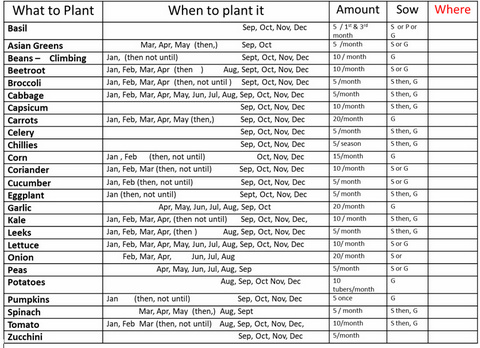Developing a plan
While a formal written plan is not necessary for you to be able to farm your Zone Zero there are a few advantages in having one!
- Process - I dunno about you, but I find if I write a plan down rather than just trying to keep it all chaotically in my head, it helps me make sense of what I am trying to do and helps me work out how I can achieve it!
- Resources – a written plan can help you make the most of scarce resources like time, money and people.
- Records – Things change, and it is good to have some documentation to refer back to check the current process with your original vision.
- Sequence – It makes it easier for things to happen in the right order or sequence, such as sowing the correct seed for the correct season.
- Goals – a plan makes it easier to set goals such as getting hold of seeds and equipment, learning how to grow from seed or experimenting with a new type or variety of food plant.
If you do decide on having a written plan, your plan should be your plan, reflecting your priorities, what you want to achieve and containing the level of detail that you are comfortable with. It can be as ad hoc as you want, or have all variables nailed down in the way described below. The main thing is that you are comfortable with it!
Now, on with the show!
There are lots of inspirational quotes about planning, the one below would be my favourite!
So, to draw up an effective plan any local dragons need to be identified and included. In order to help you identify your local dragons, there are a number of documents that currently exist in this section of the eBook –

- Assessing your Zone Zero – Helps work through Zone Zero to identify areas that can be used for growing food, based on the areas around windows, other inside areas and outside Zone Zero areas such as verandas, patios and balconies.
- Zone Zero Microclimates – Helps to identify specific microclimates in your Zone Zero that can be taken advantage of for growing specific crops. These microclimates are characterised by five environmental factors: Light, Air circulation, Temperature, Water/humidity and Soil.
- Zone Zero succession planning – This process looks at what you want to eat and how much you want to/can grow, based on the previous two documents, and helps to develop a plan that allows food crop planting to be staggered so that a yield can be harvested all year ‘round. This may include annual vegetables, mushrooms, sprouts or microgreens.

By using any or all of these documents you will be able to have an understanding of your particular dragon(s), and how to incorporate them into your planning process. If you do use all of the documents you would have an A4 grid book, with a layout of your zone zero on a grid page, Including the loungeroom, kitchen dining area, bedrooms, closets with all windows and skylights on the diagram. Also included should be any patios, decks, balconies plus the garage if that is to be used as a growing area. Overlayed on the diagram could be any specific microclimates that have been identified such as well-lit areas near a north facing window or humid areas in the laundry or bathroom.
Other food growing aspects to be considered for putting into the plan include -
- Where you want to grow your food plants? – this will require some research to consider what environment (microclimate) works best for each vegetable you want to grow, then matching them up with the growing areas that you have.
- How much of your available Zone Zero Area do you want to farm? All of it? Or just a part? This will depend on how much time you have to spare, coupled with how much you want to produce, from the space which you have available.
- Do you want it just for food, or do you want it to look nice as well? – Do you have a certain aesthetic in mind such as edible flowers perhaps, or are all veg beautiful in your eyes? If the aesthetics are important to you, consider researching ‘edible landscaping’ or ‘edible interior design’ where the look can be as important as the taste!
When considering all the variables mentioned above, I highly recommend that you also consult any friends or family that share your Zone Zero so you can take into account their likes, dislikes and most importantly, allergies. Giving them input makes it more likely that they will support and, dare I say, assist you in your Zone Zero farming endeavours.
Implementing the plan
The output of all this planning will hopefully be a series of actions that you wish to carry out so you can start farming your Zone Zero and get the benefit from all that healthy produce. One last thing that can be helpful to do before starting your Zone Zero Farm journey is to distill all those actions into an action plan.
To develop an action plan, the first thing is to write down all the actions (the ‘what’) in the correct sequence. For example, it makes sense to get hold of potting or seed raising mix, seeds and growing containers before having the action to sow those seeds.
With the list of actions set out, the next thing is to set down the ‘who’ is going to do each one. This maybe easy – it could be just you! However, if you are lucky enough to have help, it may take a bit longer to work out which helper volunteers to carry out which action.
With the ‘What’ and the ‘Who’ taken care of the next item is the ‘When’, or in other words the date by which the ‘who’ person commits to having completed the actions that they have volunteered for. Likewise, if Fred commits to obtaining the seeds for your Zone Zero Farm, it should be before the day set down in the plan to sow the seeds. Makes sense!
Depending on your mindset, you may wish to add a column for ‘How Much’ so you can allow for any costs associated with an action in your budget, such as the cost of the seeds to be sown referred to above.
Based on the actions discussed above, this is what this part of your action plan could look like -

Getting Started
Before getting started with vegetables it is worthwhile stating that it is easy to order a stack of seeds and plant out everything within reach including pots and pans, buckets, empty food tins and so on. It is easy to get carried away (I am speaking from experience here) and overcommit yourself. My suggestion is to work out the area with the best chance of success and start there. Perhaps a north facing window, deck or balcony and start small there, planting out a small number of veggies, preferably ones that are easy to grow (like radishes, lettuce or tomatoes) and maybe a herb or two and concentrate on getting a harvest from them, learning as you go.
If this seems to much you might want to start out with something simpler, like sprouts or microgreens. Take for example mung bean sprouts, they don’t need light, can be grown in a child’s school lunchbox almost anywhere. It only need you to find said lunchbox and to buy in some mung bean seeds, easily available for the nearest Asian grocery store, or if you prefer, online. Not only are they cheap and easy to grow, but you will also be able to harvest mung bean sprouts within a week of starting because they are quick to grow as well.
Has this article whetted your appetite for more info on growing food in your Zone Zero? If so, you can download the entire free eBook by clicking on this link!



